ACECH Engineering Honor Award
Ala Moana Regional Park
The Department of Design and Construction’s Ala Moana Regional Park (AMRP) project to restore and enhance the park’s features received an honor award from the American Council of Engineering Companies of Hawai‘i (ACECH) 2024 Engineering Excellence Competition. The project involved the repair of collapsed and damaged canal walls, expansion of pedestrian access at the Pi‘ikoi and Queen Street entries, and improved pond edges and paths. The project was completed in partnership with Bowers and Kubota Consulting who served as the prime consultant and provided civil engineering, regulatory permitting and planning, landscape architecture design, and contract administration support services.
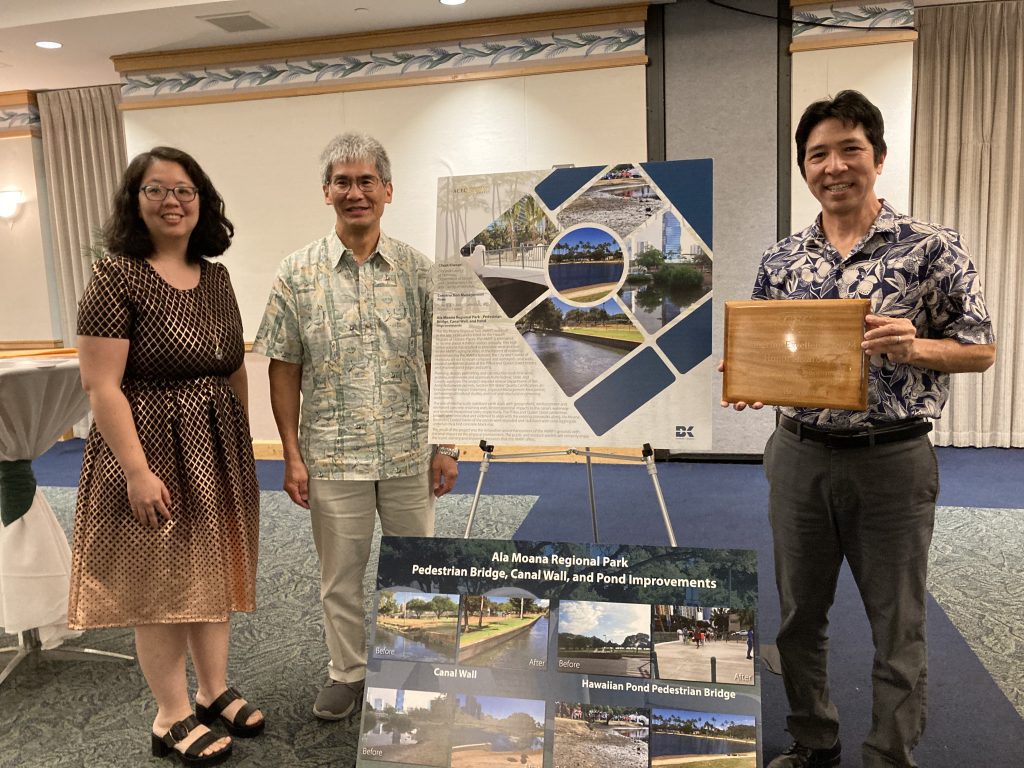
Left to Right: Bowers and Kubota Consulting Project Engineer Kristen Yoshida, DDC Facilities Division Chief Clifford Lau, and Bowers and Kubota Project Manager Eric Tamashiro received the Honor Award at the March 16 2024 ACEC awards ceremony.
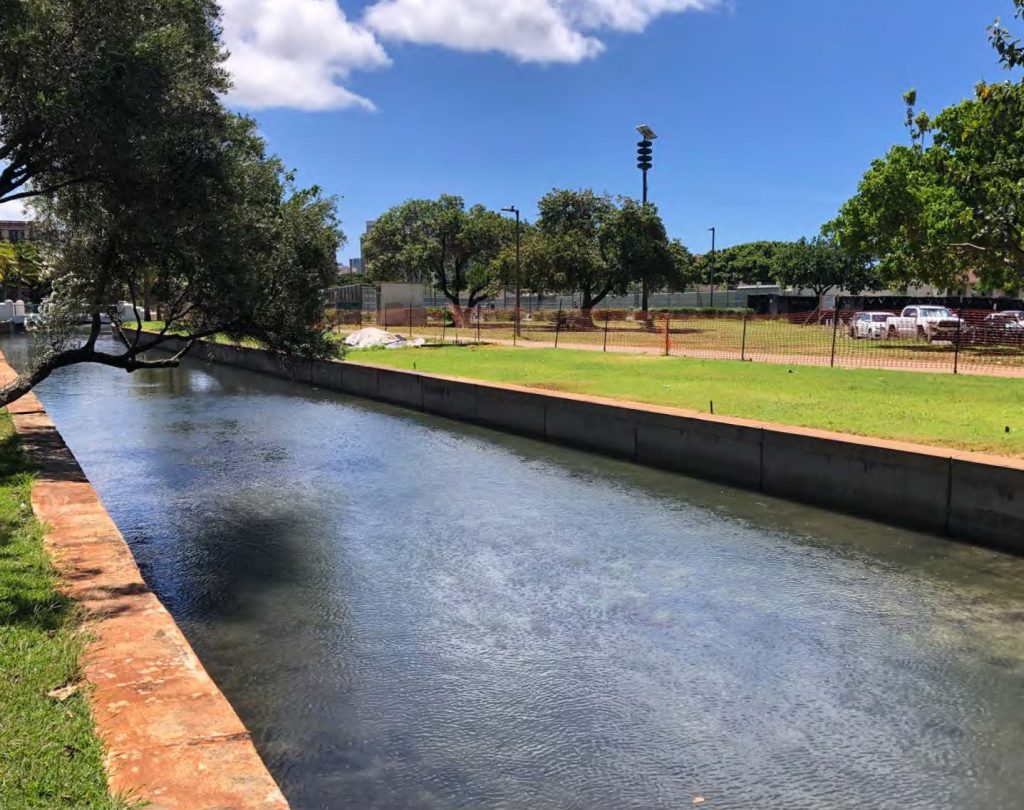
The collapsed wall on far side of the existing canal was replaced with mechanically stabilized earth wall with geosynthetic reinforcement.
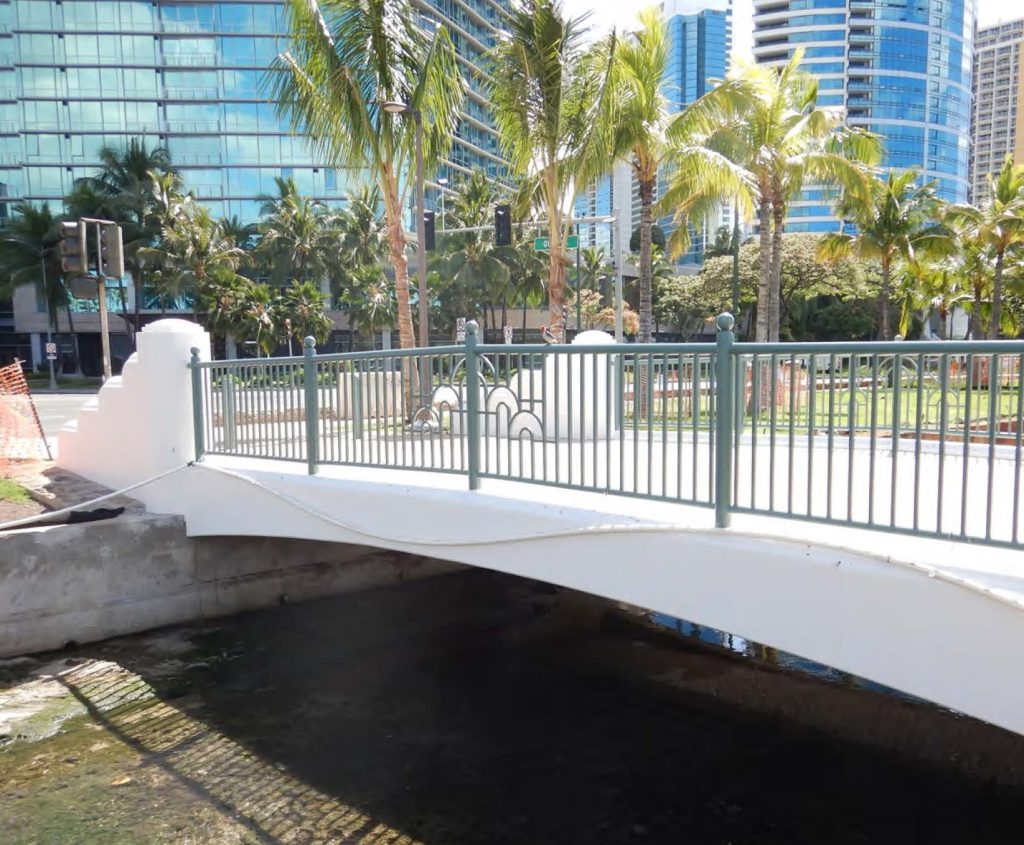
View of Queen Street Pedestrian Bridge immediately following construction.
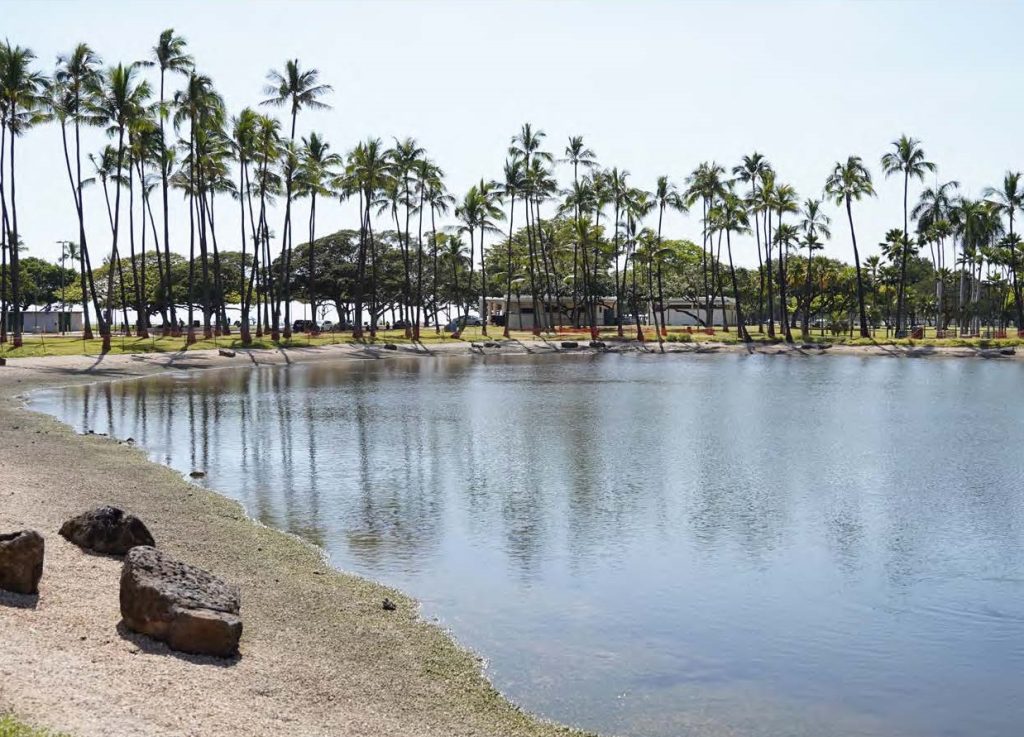
Restored Hawaiian Pond
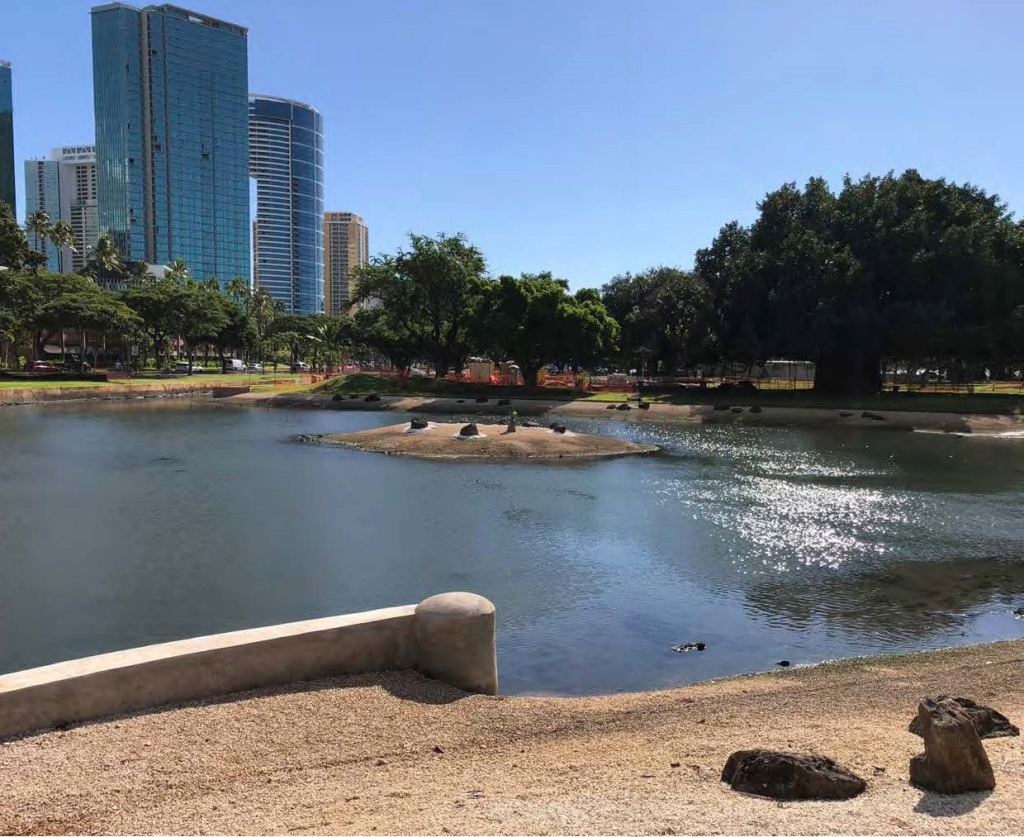
Restored Japanese Pond
Project Description
The Ala Moana Regional Park (AMRP) was built in the late 1930s and is listed on the Hawai’i Register of Historic Places. The AMRP is estimated to receive about 4 million visitors annually. This high visitor volume has resulted in extensive wear and tear to the AMRP’s aging facilities. In the interest of restoring and enhancing the AMRP’s features, the City and County of Honolulu set out to repair collapsed and damaged canal walls, expand pedestrian access at the Pi’ikoi and Queen Street entries, improve pond edges and paths, and repair the Bridle Bridge and Hawaiian Pond Bridge.
Uniqueness and/or Innovative Application of New or Existing Techniques
The design of the AMRP project integrated solutions to improve and modernize existing park features and improve the visitor experience for future generations. Following extensive research, the existing marshy conditions of the ponds were restored and enhanced with the placement of coral aggregate underlain by a tied concrete block mat. The realigned and widened pedestrian bridges provide well-defined and functional pedestrian entryways. Implementation of precast prestressed solid planks for the bridge decks significantly reduced construction times while allowing fish in the canal to freely swim through the project site. To avoid disturbing the water and fish in the canal and protect the tree roots of the landside exceptional trees, mechanically stabilized earth walls with geosynthetic reinforcement and reinforced concrete retaining walls were utilized to replace collapsed and damaged sections of the existing canal walls.
Best Management Practices (BMPs) for the work were developed for both land-based and water areas. Notable BMPs used for the project included temporary sandbag barriers, turbidity curtains, plywood platforms, and siltation basins for dewatering.
Because the the lineal feet of bank stabilization and dredge and fill volumes exceeded the limits in the respective Nationwide Permits, extensive coordination with the US Army Corps of Engineers (USACE) was conducted to ensure a smooth and quick permitting process. A waiver from the limits in the respective applicable Nationwide Permits was requested and granted by USACE. B+K’s pre-application efforts and close coordination as well as the written justification helped to convince USACE of the community importance of this project and that sufficient mitigative efforts would be installed to minimize environmental impacts.
Because of the tight project schedule, the USACE permit application was completed and submitted in two weeks from notification to proceed with the permit tasks. No major comments were received on the permit application and the NWP permit coverage was granted quickly.
Future Value to the Engineering Profession and Enhanced Public Awareness/Enthusiasm of the Role of Engineering
The AMRP project is the result of the engineering profession working with the government and community to obtain all the necessary approvals to produce an integrated design meeting the desires of all stakeholders. The project is a fine example of engineering design that takes advantage of the natural resources of site, climate, and views that the AMRP has to offer and within the construction budgets available. Local and out-of-state visitors to the park will experience the benefits of the project with its improved pedestrian paths, accessibility, and views for generations.
Because of the age of the park’s facilities and limited reference drawings available, the project team had to be nimble when unforeseen conditions were encountered during construction. Timely responses to contractor requests for information and extensive civil, structural, and electrical engineering site investigations ensured that all necessary field adjustments were properly addressed.
Social, Economic and Sustainable Design Considerations
The project was completed in compliance with all permits, without incidents. Immediately following the completion of the Pi’ikoi Street pedestrian bridge, a tour group with at least 30 visitors crossed Ala Moana Boulevard and made good use of the widened bridge and direct access to the park.
Light-emitting diode (LED) lighting improvements at the pedestrian bridge crossings and pond paths were evaluated and designed for appropriate illumination levels. In addition to safety considerations, the LED lights installed are energy efficient, have a longer life span, and will require fewer fixture replacements by the AMRP groundskeepers.
The use of coral aggregate and tied concrete block blanket provides bank stabilization, controls soil erosion due to the tidal ponds, and prevents mangroves from overtaking the site.
The community-at-large will benefit from the restored ponds, additional access paths, and lighting improvements.
Complexity
The complexity of replacing sections of the canal walls, modernizing the Pi’ikoi and Queen Street entries, improving the pond edges, and repairing the Bridle Bridge was enormous. It required extensive teamwork by the City and County of Honolulu, the consultant team, and contractors to solve design and demolition/construction challenges as needed to keep the AMRP open with minimal impact on the physical environment. The complexity of the project also lay in designing, obtaining approvals/permits, and constructing the various repair and improvement projects concurrently.
The project required several Department of the Army Nationwide permits, Section 401 Water Quality Certification, an Environmental Impact Statement, a Special Management Area permit, archaeological/cultural studies, marine/water quality studies and testing, detailed construction documents, and permits and approvals from federal, state, and county agencies.
The teamwork and cooperation between the City and County of Honolulu, contractors, and the consultant team resulted in the project successfully achieving all deadlines and milestones. The project succeeded and met the City’s goal to restore, revitalize, and enhance important site features, and extend the AMRP’s longevity for future generations.
Project success was also achieved through the City’s bid procurement process with bids less than the construction budget. Contractor change proposals, primarily limited to owner- requested additions or unforeseen conditions, were addressed in a timely manner by the project team and generally within the City’s available budget.
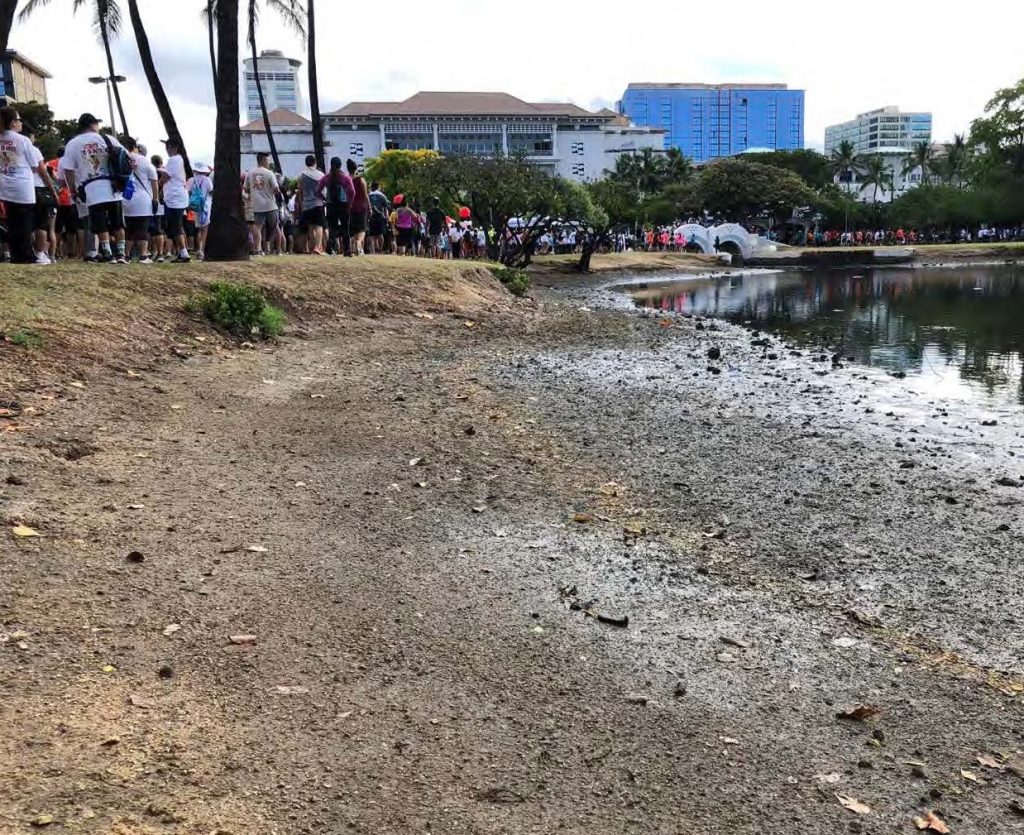
Prior to restoration, the existing condition of the Hawaiian Pond’s banks and paths was an eyesore for City maintenance staff and the public.
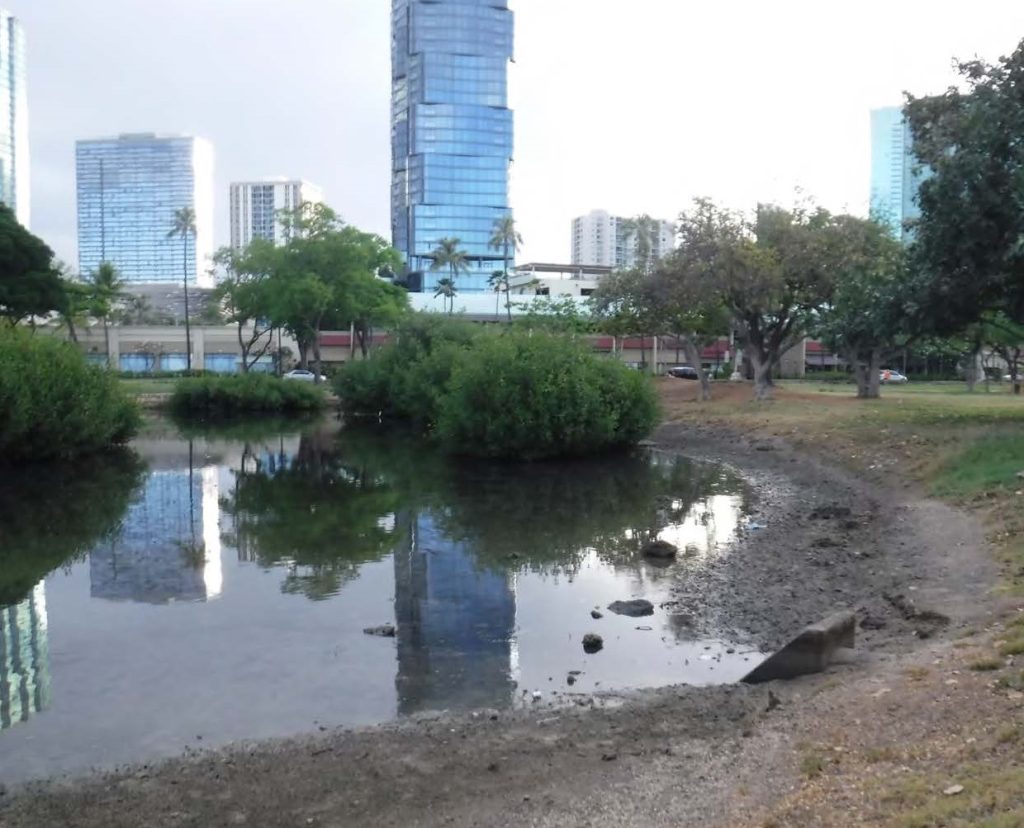
Prior to restoration, mangroves thrived in the marshy conditions of the Japanese Pond.
